In honor of the new Poltergiest re-boot opening in theaters, I thought I’d look back at the original Poltergeist and use an old academic journal article along the way.
Would you have no problem camping in the woods for several nights shortly after seeing The Blair Witch Project for the first time? What about swimming in any body of water after seeing Jaws? Or babysitting and answering the phone after seeing Scream? Or falling asleep in front of a TV after seeing Poltergeist?
Why would you have any difficulty doing any of those things? All of those movies are fictional. The deceased Blair Witch documentarians were just actors, and the shark in Jaws was a barely functional mechanical contraption. Last time I checked, Drew Berrymore has lived a long life since being gutted at the start of Scream. Sure, the legends of some kind of Poltergeist curse persists since four of the franchise’s actors died shortly after their appearances, but it’s not like any of them were felled by malevolent clown dolls or scary trees. The demon which claimed adorable, young Heather O’Rourke’s life was simply Crohn’s disease combined with medical incompetence.
However, even when we know it is irrational scary movies can stay with us for a long time. In 2004, University of Wisconsin Communication Arts professor Joanne Cantor wanted to know why that is, publishing “’I’ll Never Have a Clown in My House’-Why Movie Horror Lives On” in Poetics Today. For years in her course on media effects, she gave her students an assignment to write a paper about a frightening experience they had from television, radio, or films, making sure to report the age they were at the time of the experience, child or adult. She analyzed 530 such papers, discovering that students most often cited Poltergeist, Jaws, Blair Witch Project and Scream.
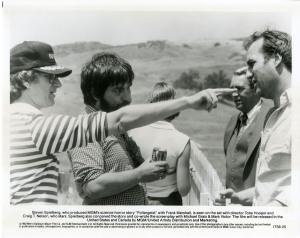 Directed by Tobe Hoober and based on an original Steven Spielberg idea and screenplay, Poltergeist is a haunted house tale of the supernatural expense of the suburban expansion of the ‘80s. It features a very Spielbergian focus on nuclear family, with signature bonding moments between father and son, and displays a clear love for genre film-making. We see Craig T. Nelson and JoBeth Williams at their best, and are horrified to see them torn down so thoroughly by the time paranormal investigators meet them after youngest daughter Carol Anne (O’Rourke) has been taken by some supernatural force. The story takes every parent’s nightmare – losing a child – and turns it up to 11 with the idea that Carol Anne can still be heard screaming for help but only through the television.
Directed by Tobe Hoober and based on an original Steven Spielberg idea and screenplay, Poltergeist is a haunted house tale of the supernatural expense of the suburban expansion of the ‘80s. It features a very Spielbergian focus on nuclear family, with signature bonding moments between father and son, and displays a clear love for genre film-making. We see Craig T. Nelson and JoBeth Williams at their best, and are horrified to see them torn down so thoroughly by the time paranormal investigators meet them after youngest daughter Carol Anne (O’Rourke) has been taken by some supernatural force. The story takes every parent’s nightmare – losing a child – and turns it up to 11 with the idea that Carol Anne can still be heard screaming for help but only through the television.
It’s not necessarily surprising that Poltergeist was the leading purveyor of fright for Cantor’s students. The papers she analyzed were from 1997-2000, and Poltergiest came out 1982 before enjoying a rich life on home video throughout the decade and on cable in the 90s. Her students self-reported ages between 4 and 10 for when they first saw the movie, and research in developmental psychology suggests that some kids don’t learn to distinguish between fantasy and reality in the media (i.e., truly understand that what they see on TV is physically impossible in the real world) until they are 7 or 8.
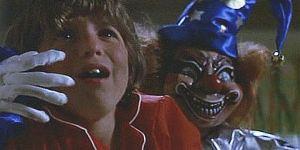
James Wan went on to put this image to good use in Saw and The Conjuring
That’s roughly how old some of Poltergeist’s famous fans were when they first saw it. James Wan was 7-years-old when he saw Poltergeist (1982), and the scene in which the young boy’s benign clown doll comes to life and attempts to kill him left Wan with a lifelong interest in “creepy dolls.” He’s put that to good use, with the Jigsaw doll in Saw, the Raggedy Ann-esque Annabelle doll in The Conjuring, etc. For Diablo Cody, of Juno and Jennifer’s Body fame, Poltergeist was actually her first horror film, and she was either 7 or 8 when she saw it. As she told People, “I was allowed to see it because it was PG. The ratings guidelines have changed now, but there is a man tearing his face off in that. It’s this violent, visceral film that played on everything that children like: TV and toys. It was sadistic.”
More than just that playing on a child’s love for TV and toys, Poltergiest turns a misshapen tree, i.e., a scary but ultimately harmless facet of nature, into a completely malevolent entity which transforms into a monster and reaches into the seemingly safe space of a kid’s bedroom to snatch him away to danger. Plus, kids are classically scared of the thing under the bed and the monster in the closet, and in Poltergeist there is indeed something under the bed to be scared of and the closet tries to suck the kids into another dimension. Everyone ultimately survives. Craig T. Nelson and company escape to a hotel room, but the poltergeists and demons are not really vanquished.
The standard reaction for a little kid in response to such an unnerving viewing experience is to sleep with the lights on and suffer through days or weeks of nightmares, maybe sleeping in bed with your parents for a couple of nights. You can also take all sorts of irrational steps to somehow protect yourself from the bad guys in the movie. One of Cantor’s students admitted that after seeing Poltergiest she actually cut her hair shorter thinking that since Carol Anne had long blonde hair the bad people who took her must only have a thing for girls with long hair.
Eventually, though, you move on. But how long does that take? And at what point do you stop being scared of clowns because of what you saw in the movie?
Here are some of the experiences Cantor’s students shared:
Clowns!
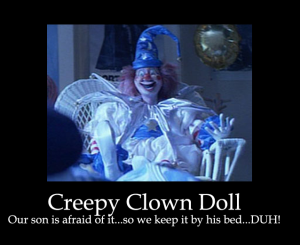 –I still hate clowns. My grandma, the sweetest lady in the world, used to dress up as a clown and go around children’s hospitals cheering them up. I love her…until she put that clown suit on with the wig and make-up and everything. That was the moment when she became something else. I was deathly afraid to ride in the same car with her.
–I still hate clowns. My grandma, the sweetest lady in the world, used to dress up as a clown and go around children’s hospitals cheering them up. I love her…until she put that clown suit on with the wig and make-up and everything. That was the moment when she became something else. I was deathly afraid to ride in the same car with her.
–To this day, I am scared of clowns and will never have one in my house, even when I have children.
Television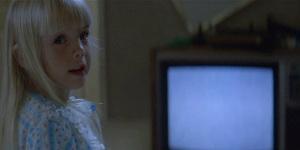
–After seeing Poltergiest, I couldn’t sleep knowing the television was there. I stayed up the entire night watching the television to make sure it wouldn’t come to life. The next day, I immediately told my parents and asked them to remove the set.
–Even now, I certainly don’t leave my TV on after the station goes off the air, and I still always make sure that my closet door is closed before I go to sleep.
Trees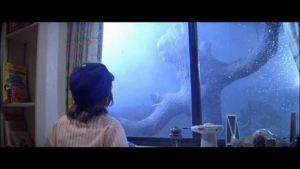
–For years after that night I was afraid of trees outside my window at night. It took me a long time to shake that fear.
The comment I personally related to was not specific to the clown, TV or trees, but instead about the way Poltergeist made you feel the need to tiptoe around your childhood bedroom to ensure that nothing under the bed would grab you:
Once during the film he looked under his bed only to find a port-hole to another dimension. Because of this, for about six months I would jump from my doorway to my bedroom to my bed, so nothing under my bed could grab me.
Some of this is just innocent childhood tales of letting a movie get to you. Research in developmental psychology partially explains why that might happen for audiences of a certain age. Cantor further pointed to research which suggests little kids struggle to understand transformations meaning the metamorphous of the benign (like a clown doll or tree outside bedroom the window) into something monstrous is especially horrifying. Plus, you can think through ways you could logically escape a masked killer or avoid bodies of water where sharks might be nearby. The ghosts of Poltergiest are entirely un-tethered from reality meaning you can’t as easily mount logical defenses. Sure, you know none of it’s real, yet as you fall asleep at night you look out the window at that dang tree and think that if it did come to life you’d be fairly screwed.
But why would we still be afraid of clowns well into adulthood just because of that time a fake clown tried to kill a fictional character in a movie? Or trees outside of our bedroom windows? Cantor concluded the answer lies in neuroscience. Essentially, the more scared we are of a certain set of stimuli at a young age the more likely we are to have been conditioned to always at least kind of register that same reaction long after our conscious minds have gotten past the problem. Of course, this only happens to a small percentage of viewers. Less than a third (31%) Cantor’s students who cited Poltergeist as their most frightening film reported any kind of ongoing life effects. 72% admitted the film gave them nightmares, but only 7% said the film would still give them nightmares.
For those who were affected, they protected themselves from Poltergeist by cutting their hair, turning off TVs or getting rid of them entirely, making sure to always sleep with the closet door closed, tiptoeing around the bedroom to avoid being grabbed by the monster under the bed, and closing window drapes to avoid looking at a scary tree. What are some of the adorably irrational behaviors you’ve ever adopted to “protect yourself” from a horror movie?
Source: Poetics Today

